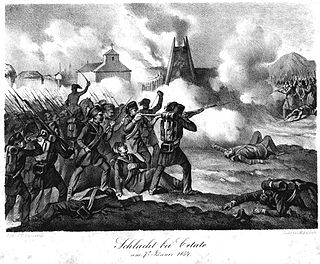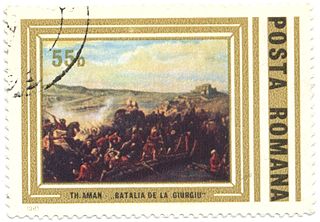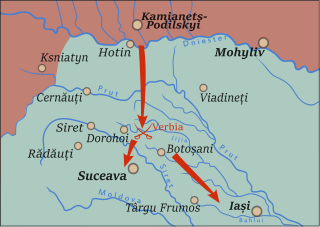 W
WThe military history of Romania deals with conflicts spreading over a period of about 2500 years across the territory of modern Romania, the Balkan Peninsula and Eastern Europe and the role of the Romanian military in conflicts and peacekeeping worldwide.
 W
WThe Battle of Baia was fought on December 15, 1467, between the Moldavian prince, Stephen the Great and Hungarian king, Matthias Corvinus. The battle was the last Hungarian attempt to subdue the independent Moldavia, as previous attempts had ended in failure. Corvinus invaded Moldavia as a consequence of Stephen's annexation of Chilia—a fortress and harbour at the coast of the Black Sea, which at the time was controlled by Hungarian and Wallachian forces, though it had belonged to Moldavia centuries earlier.
 W
WThe Battle of Călugăreni was one of the most important battles in the history of early modern Romania. It took place on 23 August 1595 between the Wallachian army led by Michael the Brave and the Ottoman army led by Koca Sinan Pasha. It was part of the Long War, fought between Christian and Ottoman forces at the end of the 16th – beginning of the 17th centuries.
 W
WThe Battle of Cetate was fought during the Crimean War. In this battle a large Ottoman force under Ahmed Pasha attempted to capture the village of Cetate in Wallachia, controlled by the troops of Colonel Alexander Baumgarten, but were unsuccessful.
 W
WThe Battle of Oltenița was fought on 4 November 1853 and was the first engagement of the Crimean War. In this battle an Ottoman army under the command of Omar Pasha was defending its fortified positions from the Russian forces led by General Peter Dannenberg, until the Russians were ordered to withdraw. The battle was indecisive, with both sides claiming victory. The Russian attack was called off just when Dannenberg's troops reached the Ottoman fortifications, and they moved back in full order, yet unwillingly. The Turks held their positions, but their success was insignificant, and they retreated afterwards.
 W
WThe Battle of Rymnik on September 22, 1789 took place in Wallachia, near Râmnicu Sărat, during the Russo-Turkish War of 1787-1792. The Russian general Alexander Suvorov, acting together with the Habsburg general Prince Josias of Coburg, attacked the main Ottoman army under Grand Vizier Cenaze Hasan Pasha. The result was a crushing Russo-Austrian victory.
 W
WThe Battle of Cecora was a battle during the Polish–Ottoman War (1620–21) between the Polish–Lithuanian Commonwealth and Ottoman forces, fought from 17 September to 7 October 1620 in Moldavia, near the Prut River.
 W
WThe Battle of Brașov was fought on July 17, 1603, between the troops of Wallachia led by Radu Șerban and the Habsburg Empire on one side and the Transylvanian troops led by Mózes Székely on the other side.
 W
WThe Battle of Cecora took place on October 19–20, 1595, during an expedition of Jan Zamoyski, of the Polish-Lithuanian Commonwealth, to Moldavia, as part of the Moldavian Magnate Wars.
 W
WThe Battle of Focșani was a battle in the Russo-Turkish War (1787–1792) fought on 1 August 1789 between the Ottoman Empire and the alliance of the Russian Empire and the Habsburg Monarchy near Focșani, Moldavia. The Russians were led by Alexander Suvorov, the Austrians by Prince Josias of Coburg, and the Ottomans by Osman Pasha.
 W
WThe Battle of Giurgiu took place on 27–30 October 1595. It was part of the Long War(1591/1593–1606), a border conflict between the Habsburg Monarchy and the Ottoman Empire over Balkan territories.
 W
WThe Battle of Guruslău or Battle of Goroszló was fought on 3 August 1601, between the troops of the Habsburg Monarchy led by Giorgio Basta, the Cossacks and Wallachia led by Michael the Brave on one side and the Transylvanian troops led by Sigismund Báthory on the other side. It was part of a series of military encounters developed between the Ottoman Empire and opposing European states during 1591–1606.
 W
WThe Battle of Ongal took place in the summer of 680 in the Ongal area, an unspecified location in and around the Danube delta near the Peuce Island, present-day Tulcea County, Romania. It was fought between the Bulgars, who had recently invaded the Balkans, and the Eastern Roman Empire, which ultimately lost the battle. The battle was crucial for the creation of the First Bulgarian Empire.
 W
WThe Russo-Ottoman War of 1710–11, also known as the Pruth River Campaign after the main event of the war, erupted as a consequence of the defeat of Sweden by the Russian Empire in the Battle of Poltava in the summer of 1709 and the escape of the wounded King Charles XII of Sweden and his large retinue to the Ottoman fortress of Bender. Sultan Ahmed III declined incessant Russian demands for Charles's eviction, prompting Tsar Peter I of Russia to attack the Ottoman Empire, which in its turn declared war on Russia on 20 November 1710. Concurrently with these events, the Prince Dimitrie Cantemir of Moldavia and Tsar Peter signed the Treaty of Lutsk, by which Moldavia pledged to support Russia in its war against the Ottomans with troops and by allowing the Russian army to cross its territory and place garrisons in Moldavian fortresses. After having gathered near the Moldavian capital Iași, the combined Russo-Moldavian army started on 11 July the march southwards along the Prut River with the intention of crossing the Danube and invading the Balkan peninsula.
 W
WThe Romanian People's Army was the army of the Romanian Communist Party and the Socialist Republic of Romania from 1947 to 1989. It was dissolved following the Romanian Revolution in 1989 and retained its current form through the Romanian Armed Forces. It consisted of the People's Ground Forces, the People's Navy and the People's Air Force.
 W
WThe Battle of Şelimbăr or Battle of Sellenberk took place on 18 October 1599 between the Romanian army of Michael the Brave and the Transylvanian-Hungarian army of Andrew Báthory. The battle was fought near the village of Șelimbăr close to Sibiu.
 W
WThe Battle of Valea Albă or Battle of Războieni or Battle of Akdere was an important event in the medieval history of Moldavia. It took place at Războieni, also known as Valea Albă, on July 26, 1476, between the Moldavian army of Ştefan cel Mare and an invading Ottoman army which was commanded personally by Sultan Mehmed the Conqueror.
 W
WThe Battle of Vaslui was fought on 10 January 1475, between Stephen III of Moldavia and the Ottoman governor of Rumelia, Hadım Suleiman Pasha. The battle took place at Podul Înalt, near the town of Vaslui, in Moldavia. The Ottoman troops numbered up to 120,000, facing about 40,000 Moldavian troops, plus smaller numbers of allied and mercenary troops.
 W
WThe Battle of Verbia was the decisive episode in Iacob Heraclid (Despot)'s invasion of Moldavia, taking place on November 18, 1561. Heraclid and Olbracht Łaski's army was backed by the Holy Roman Empire and possibly also by the Knights Hospitaller; it comprised foreign mercenaries, including Spaniards armed with arquebuses, making this the first battle in Moldavian history to be won by superior firepower. The Moldavian military forces under Prince Alexandru Lăpușneanu were backed by Janissaries, but lost crucial support from the cavalry when commander Moțoc defected to the enemy. From the village of Verbia, located outside Dimăcheni, Heraclid's Hungarian troops stormed into Botoșani, slaughtering the surviving Janissaries.
 W
WBattle of Zsibó was fought on November 15, 1705 between the Kuruc (Hungarian) army and forces of the Habsburg Empire, Kingdom of Denmark and Vojvodian Serbs in Zsibó, Principality of Transylvania. The Austrian marshal Ludwig Herbeville marched against Transylvania. Although the Kuruc-French army was equal in size to the combined Austrian, Danish and Serbian forces, Francis II Rákóczi went on the defense due to the inferior training of his troops. The Danes and Austrians launched a powerful attack on the French and Kuruc infantry. Although the Kuruc infantry held its ground, the Kuruc cavalry could not launch an attack due to a lack of leadership and an overly muddy battlefield. The Austrian cavalry was thus capable of flanking the Hungarians on the left, forcing the Hungarians to retreat and crushing their cavalry in the process. After the battle, the combined Austrian-Danish army bought Transylvania.